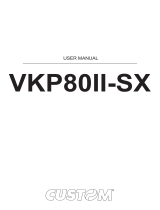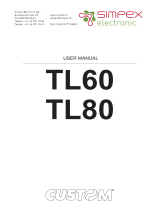Page is loading ...

USER MANUAL
KPM180H
TK180
AVIATION


The format used for this manual improves use of natural resources reducing the quantity of necessary paper to print this copy.
CUSTOM S.p.A.
Via Berettine 2/B
43010 Fontevivo (PARMA) - Italy
Tel. : +39 0521-680111
Fax : +39 0521-610701
http: www.custom.biz
Customer Service Department:
Email : [email protected]
© 2017 CUSTOM S.p.A. – Italy.
All rights reserved. Total or partial reproduction of
this manual in whatever form, whether by printed
or electronic means, is forbidden. While guaran-
teeing that the information contained in it has been
carefully checked, CUSTOM S.p.A. and other
entities utilized in the realization of this manual
bear no responsibility for how the manual is used.
Information regarding any errors found in it or
suggestions on how it could be improved are
appreciated. Since products are subject to con-
tinuous check and improvement, CUSTOM S.p.A.
reserves the right to make changes in information
The pre-installed multimedia contents are pro-
tected from Copyright CUSTOM S.p.A. Other
company and product names mentioned herein
may be trademarks of their respective companies.
Mention of third-party products is for informa-
tional purposes only and constitutes neither an
endorsement nor a recommendation. CUSTOM
S.p.A. assumes no responsibility with regard to
the performance or use of these products.
THE IMAGES USED IN THIS MAN-
UAL ARE USED AS AN ILLUSTRA-
TIVE EXAMPLES. THEY COULDN’T
REPRODUCE THE DESCRIBED
MODEL FAITHFULLY.
UNLESS OTHERWISE SPECIFIED,
THE INFORMATION GIVEN IN THIS
MANUAL
ARE REFERRED TO ALL MODELS
IN PRODUCTION AT THE ISSUE
DATE OF THIS DOCUMENT.
GENERAL INSTRUCTIONS
CUSTOM S.p.A. declines all responsibility for
accidents or damage to persons or property
occurring as a result of tampering, structural or
installations, environments not in keeping with
the equipment’s protection degree or with the
required temperature and humidity conditions,
failure to carry out maintenance and periodical
inspections and poor repair work.
GENERAL SAFETY INFORMATION
Your attention is drawn to the following actions
that could compromise the characteristics of the
product:
• Read and retain the instructions which follow.
• Follow all indications and instructions given
on the device.
• Make sure that the surface on which the device
rests is stable. If it is not, the device could fall,
seriously damaging it.
• Make sure that the device rests on a hard (non-
ventilation.
•
provided in this manual.
• When positioning the device, make sure cables
do not get damaged.
• [Only OEM equipment] The equipment must
be installed in a kiosk or system that provides
• The mains power supply must comply with the
rules in force in the Country where you intend
to install the equipment.
• Make sure that there is an easily-accessible
outlet with a capacity of no less than 10A closely
to where the device is to be installed.
• Make sure the power cable provided with the
appliance, or that you intend to use is suitable
with the wall socket available in the system.
• Make sure the electrical system that supplies
power to the device is equipped with a ground
wire and is protected by a differential switch.
• Before any type of work is done on the machine,
disconnect the power supply.
• Use the type of electrical power supply indi-
cated on the device label.
• These devices are intended to be powered
ing an SELV, non-energy hazardous output.
(IEC60950-1 second edition).
• [Only POS equipment] The energy to the
equipment must be provided by power supply
approved by CUSTOM S.p.A.
• Take care the operating temperature range of
equipment and its ancillary components.
• Do not block the ventilation openings.
• Do not insert objects inside the device as this
could cause short-circuiting or damage compo-
nents that could jeopardize printer functioning.
• Do not carry out repairs on the device yourself,
except for the normal maintenance operations
given in the user manual.
• The equipment must be accessible on these
components only to trained, authorized per-
sonnel.
• Periodically perform scheduled maintenance on
the device to avoid dirt build-up that could com-
promise the correct, safe operation of the unit.
• Do not touch the head heating line with bare
hands or metal objects. Do not perform any
operation inside the printer immediately after
printing because the head and motor tend to
become very hot.
• Use consumables approved by CUSTOM S.p.A.
THE CE MARK AFFIXED TO THE
PRODUCT CERTIFY THAT THE
PRODUCT SATISFIES THE BA-
SIC SAFETY REQUIREMENTS.
The device is in conformity with the essential
Electromagnetic Compatibility and Electric Safety
requirements laid down in Directives 2006/95/CE
and 2004/108/CE inasmuch as it was designed
in conformity with the provisions laid down in the
following Standards:
• EN 55022 Class B (Limits and methods of
measurements of radio disturbance charac-
teristics of Information Technology Equipment)
• EN 55024 (Information Technology Equip-
ment – Immunity characteristics – Limits and
methods of measurement)
• EN 60950-1 (Safety of information equipment
including electrical business equipment)
The device is in conformity with the essential
requirements laid down in Directives 1999/05/CE
about devices equipped with intentional radiators
The Declaration of Conformity and other available
please providing the correct part number shown
on product label or in the invoice.
GUIDELINES FOR
THE DISPOSAL OF
THE PRODUCT
The crossed-out rubbish bin logo means that
used electrical and electronic products shall NOT
be mixed with unsorted municipal waste. For
more detailed information about recycling of this
product, refer to the instructions of your country
for the disposal of these products.
• Do not dispose of this equipment as miscel-
laneous solid municipal waste, but arrange to
have it collected separately.
• The re-use or correct recycling of the electronic
and electrical equipment (EEE) is important
in order to protect the environment and the
wellbeing of humans.
• In accordance with European Directive WEEE
2002/96/EC, special collection points are
available to which to deliver waste electrical
and electronic equipment and the equipment
can also be handed over to a distributor at the
moment of purchasing a new equivalent type.
• The public administration and producers of
electrical and electronic equipment are involved
in facilitating the processes of the re-use and
recovery of waste electrical and electronic
equipment through the organisation of col-
lection activities and the use of appropriate
planning arrangements.
• Unauthorised disposal of waste electrical and
electronic equipment is punishable by law with
the appropriate penalties.


TABLE OF CONTENTS
1 INTRODUCTION ..............................................................7
2 IDENTIFICATION OF THE MODELS ........................................9
3 DESCRIPTION ...............................................................11
3.1 Box contents ......................................................................11
3.2 Device components: external views ....................................................16
3.3 Device components: keys and connectors panel ..........................................21
3.4 Device components: internal views ....................................................22
3.5 Product label ......................................................................25
3.6 Key functions: power up .............................................................26
3.7 Key functions: standby ..............................................................27
3.8 Status messages ..................................................................28
3.9 Display messages ..................................................................29
4 INSTALLATION ...............................................................31
4.1 Fastening ........................................................................31
4.2 Low paper sensor ..................................................................36
4.3 Connections ......................................................................38
4.4 Pinout ...........................................................................39
4.5 Driver and SDK ....................................................................42
5 OPERATION ..................................................................43
5.1 Opening device cover ...............................................................43
5.2 Adjusting paper width ...............................................................45
5.3 Adjusting the alignment sensors .......................................................46
5.4 Switch the device on ................................................................48
5.5 Loading the paper roll ...............................................................54
5.6 Issuing ticket .....................................................................57
6 CONFIGURATION ............................................................61
................................................................61
6.2 Setup report ......................................................................62
6.3 Device status .....................................................................64
6.4 Printer parameters .................................................................65
6.5 Ethernet parameters ................................................................70
6.6 Hexadecimal dump .................................................................71
5

7 MAINTENANCE ..............................................................73
7.1 Printer paper jam ..................................................................73
7.2 Autocutter paper jam ................................................................74
7.3 Planning of cleaning operations .......................................................76
7.4 Cleaning .........................................................................77
..................................................................81
8 SPECIFICATION .............................................................83
.............................................................83
8.2 Device dimensions .................................................................86
8.3 Device dimensions with pretensioner module ............................................91
8.4 Device dimensions with paper roll holder ................................................93
8.5 Device dimensions with paper roll holder ................................................94
8.6 Dimensions of power supply ..........................................................95
9 ACCESSORIES ..............................................................97
10 ALIGNMENT ................................................................101
10.1 Enable alignment ................................................................102
10.2 Calibration ......................................................................103
11 TECHNICAL SERVICE ....................................................107
12 ADVANCED FUNCTIONS .................................................109
12.1 File sharing .....................................................................109
12.2 Drivers installation ...............................................................109
12.3 Setup .........................................................................110
6

1 INTRODUCTION
This document is divided into sections and chapters. Each chapter can be reached by the index at the beginning of this
document. The index can be reached by the button on each page as shown in the diagram below.
5 CONFIGURATION
5.1 Setup parameters
AAAA, BBBB
When the printer is turned on it performs a self-test and reset routine
that checks
and initializes the following electronic and mechanical
components.
When the printer is turned on it performs a self-test and reset routine(1)
that checks
and initializes the following electronic and mechanical
components.
During
power-up, if the LF LINE FEED key is held down,
the printer enters the autotest routi-
ne and prints out the Setup report.
The printer permits the configuration of default
parameters.
CCCC
During power-up, if the LF LINE FEED key is held down,
the printer enters the auto-
test routine and prints out the Setup report.
The printer permits the configuration of
default parameters.
Numbered title
for chapter
Numbered title
for paragraph
Information valid
for devices
AAAA, BBBB, CCC
Information valid
for device CCCC
Information valid
for devices AAAA, BBBB
Generic information or
suggestions for the use
of the devices
Information or
suggestions related to
specific operations
Useful information to
not compromise
devices operation
Link to table of contents
Notes reference
NOTES:
All the dimensions shown in figures are in millimetres.
(1) For the keys functions refer to the chapter 2.
ATTENTION: Respect power supply polarity.
7

2 IDENTIFICATION OF THE MODELS
NOMENCLATURE DESCRIPTION
KPM180H STD
KPM180H PRES KPM180H STD with presenter
KPM180H PRES UHF KPM180H PRES with RFID reader/writer
TK180 MET
TK180 PLAS
9

3 DESCRIPTION
3.1 Box contents
re-used if the device is to be transported in the future.
Make sure that all the components illustrated below are present and that there are no signs of damage. If there are, contact
Customer Service.
KPM180H STD
1. Installation instruction sheet
2. Device
3. Paper block guide
4. External low paper sensor with
cable
5. Reducer for paper width
1
2
4
5
3
11

3.2 Device components: external views
KPM180H STD
1. Device chassis
2. Device cover
3. Opening lever for device cover
4. Paper out
5. Status LED
6. LF LINE FEED key
7. FF FORM FEED key
8. Paper input
9. Adjustable cursor for paper in
10. Keys and connectors panel
(see following paragraphs)
11. Product label
234 1
8
9
11
6
7
5
10
16

KPM180H PRES
1. Device chassis
2. Device cover
3. Opening lever for device cover
4. Opening lever for presenter
cover
5. Paper out
6. Status LED
7. LF LINE FEED key
8. FF FORM FEED key
9. Presenter chassis
10. Paper input
11. Adjustable cursor for paper in
12. Keys and connectors panel
(see following paragraphs)
13. Product label
234 1
10
8
9
13
6
7
5
11
12
17

KPM180H PRES UHF
1. RFID support chassis
2. Device chassis
3. Opening lever for device cover
4. Device cover
5. Opening lever for presenter
cover
6. Paper out
7. Status LED
8. LF LINE FEED key
9. FF FORM FEED key
10. Presenter chassis
11. Adjustable cursor for paper in
12. Paper input
13. Keys and connectors panel
(see following paragraphs)
14. Product label
4 35 2 1
12
9
10
14
7
8
6
11
13
4 35 2 1
12
9
10
14
7
8
6
11
18
/















